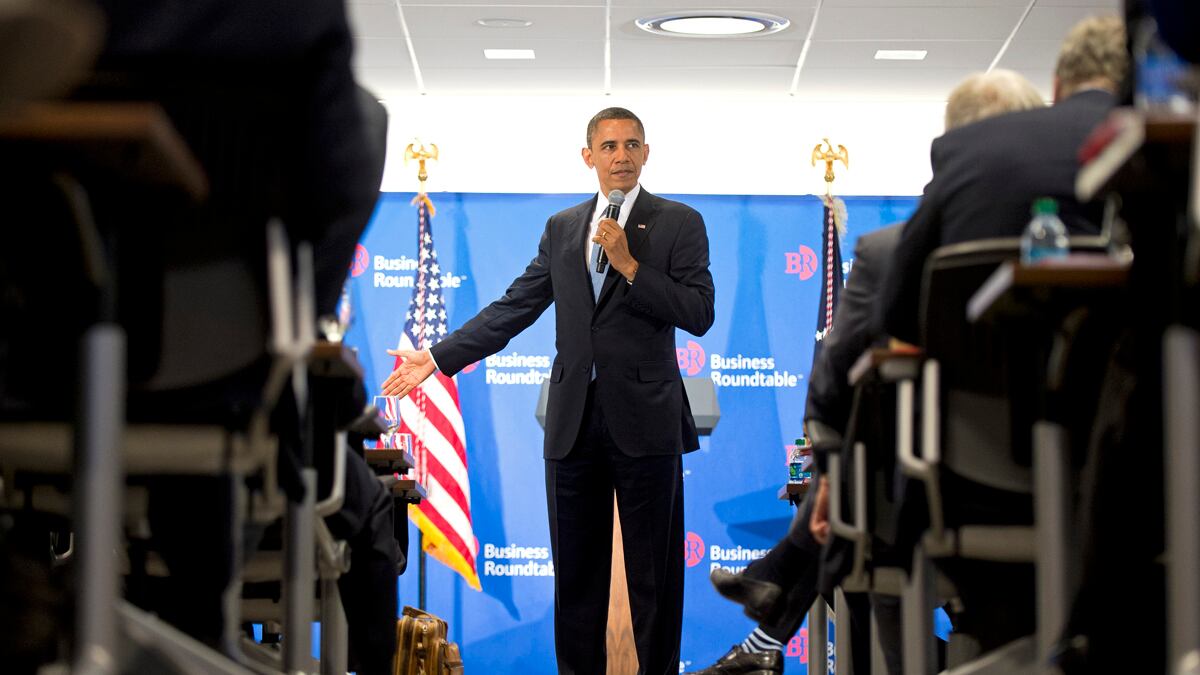The Obama administration and its allies are so desperate to portray tax hikes on the rich as the solution to all our problems that they’re trying to persuade the public that tax cuts for the rich caused all those problems.

Perhaps the most outrageous expression of this argument comes in “Tax the Rich: An Animated Fairy Tale,” a new video from the California Federation of Teachers.
This eight-minute piece of puerile propaganda features the warm and winning voice of Ed Asner. The 83-year-old Hollywood legend’s vocal talents have recently powered far more worthy animated projects, including the fanciful, Oscar-winning Disney-Pixar masterpiece Up.
In “Tax the Rich,” Asner instead goes down—tracing America’s steep decline from the golden age before tax cuts for the rich brought about the suffering and despair of the present day. “Once upon a time,” he intones, “there was a land that was happy and prosperous. They had a great education system, safe streets, and jobs for everyone.”
Never mind that during the idyllic Jimmy Carter era of 70 percent top marginal tax rates, violent crime on those “safe streets” occurred at nearly double the rates of today. Or that the Carter unemployment number of 7.6 percent at the end of his term nearly equaled today’s level of joblessness and hardly provided “jobs for everyone.” Asner’s narration insists that high levels of taxation created a virtual utopia: “The people of this land paid for their good life by investing in their future together. They called this ‘paying taxes.’”
Then the serpent of greed slithered into this American Eden: “But over time rich people decided they weren’t rich enough. So they came up with ways to get richer. The first way was through tax cuts.” The animation cleverly illustrates this reduction in rates with giant scissors slicing away—cue heavily amplified sound effects—cutting up benign images of parks and schools like menacing instruments of national castration.
Asner’s concluding question appears with images of arioused masses deploying signs demanding “Tax the Rich” and “Tax Corporations.” To end on a potentially hopeful note, the kindly narrator inquires: “Can the people of this land do something to live happily ever after?” Accompanying material from the California Federation of Teachers urges concerned citizens to “do something” by getting involved in support of President Obama’s effort to raise tax rates on prosperous taxpayers.
The idea that national happiness depends on piling higher tax burdens on the wealthy is no more irrational than the notion that lower tax rates on top earners somehow led to devastating declines in funding for schools, public safety, parks, transportation, and other public needs.
Since Ronald Reagan became president and began wielding those menacing scissors to cut tax rates, total education spending per student has nearly doubled. On the federal level, the U.S. Department of Education spent $14.2 billion in constant dollars when Reagan came to Washington, but the budget rose to $56 billion in 2006 under President George W. Bush. From that point forward, with the reduced Bush tax rates firmly in place, spending soared again to $71 billion in 2011.
The perceived decline in transportation infrastructure, depicted with cracked and potholed streets in the Asner video, also bears less connection to overall funding cuts, which never occurred, than to the futile folly of diverting highway money to wildly impractical mass transit boondoggles. Since the era of Reagan and Bush tax cuts, government at every level has invested lavishly in ill-considered and outrageously expensive train systems in Seattle, Portland, Atlanta, Detroit, Los Angeles, and countless other cities, delivering pointless projects, that have done nothing to relieve traffic or reduce commute times. Now California and the federal government mean to collaborate on a laughably impractical high-speed rail system that could cost $100 billion. A first-stage route will connect an underpopulated corridor between Merced and Bakersfield, with a serious environmental impact on desert toads but no impact whatever on Los Angeles’s clogged freeways.
The bottom line in federal outlays also shows that tax cuts of the Reagan and Bush era did nothing to force a reduction in overall levels of spending. In 2000, the last full year of President Clinton’s purportedly perfect reign of peace and prosperity, the federal government spent 18.2 percent of the gross domestic product. Eight years later, after two rounds of major tax cuts and in the last full year of the Bush presidency, Washington spent 20.8 percent of GDP, a substantial explosion of additional spending, not the imposition of some brutal austerity budget. After four years of Obama’s leadership, with the Bush tax rates still firmly in place—for a few weeks more, at least—we now spend 24.3 percent, another perilous rise. While Grover Norquist, purveyor of the now notorious “no new taxes” pledge, popularized the phrase “starve the beast” as a demand for leaner, more effective government, it ought to be obvious that the beast in question now suffers from an acute obesity problem.
The most obnoxious element in the new animated fairy tale from the Golden State’s education establishment is its demonization of malevolent and immoral “rich people,” depicting them as a separate, subhuman species and not merely a privileged class. In one outrageous image, the rich perch on top of the scales of justice and urinate in a golden waterfall on the unsuspected poor, who are huddled beneath them on the lower plate of the balance.
Of course Asner himself, and the other millionaire Hollywood activists who clamor for higher tax rates, could rain their own showers of gold on supposedly starved parks and schools and firehouses. But they prefer to fund propaganda, demanding the seizure of even more money from their fellow plutocrats. In the last election cycle, Democrats received and spent more than $3 billion in donations; imagine the acreage of wilderness and open space that might have been purchased with even a small portion of those contributions.
Identifying the rich with wanton cruelty and urinating-on-their-heads contempt is a sad attempt at foment the irrational urge to punish them with higher tax rates as the best way to lead America back to the land of “happily ever after.” This animated animus also could justify the fear expressed by the wealthy in the cartoon that an enraged populace “might take some of our money,” as if sanctity of private property counted for nothing in the face of emotional indignation. Later, Asner’s narration notes that “people began to say maybe the rich have too much money now,” suggesting that the public has the right to determine the maximum levels of success that productive members of society ought to be allowed to achieve.
Of course, liberal reasoning never attempts to explain how limiting such success could serve the interests of the less fortunate. Nor will the left make any attempt to sketch a rational cause-and-effect relationship between hiking tax rates and improving public services, or to establish a connection between tax rate cuts and public suffering for anyone. Despite the lurid animation from the California teachers union and skillful narration by one of Hollywood’s liberal lions, those associations remain an irresponsible example of fairytale logic.






